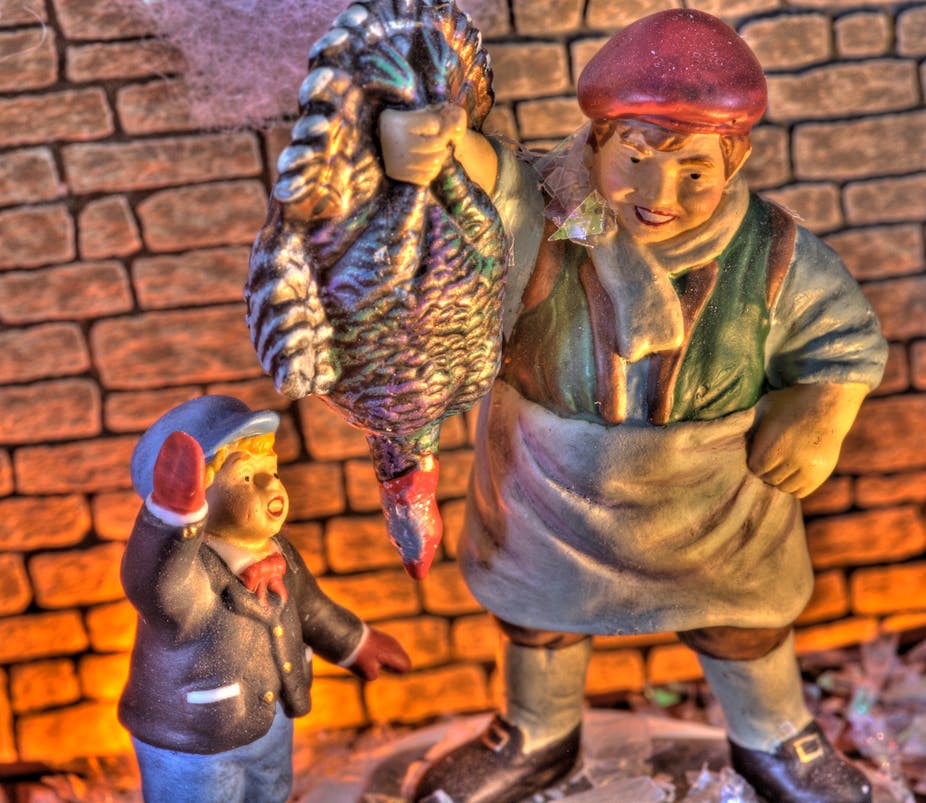In much of the English-speaking world Christmas dinner involves the consumption of turkey – but that was not always the case. The origins of this ritual can be traced back to the generous act of one Ebenezer Scrooge, the reformed miser who on Christmas Day gave a grand turkey to his overworked clerk, Cratchit, in Charles Dickens’ 1843 novella A Christmas Carol.
The power of Dickens
From its initial publication, and ever since, the Carol has been popular. Even today, 170 years later, the infamous Ebenezer Scrooge continues to pleasantly haunt our homes through the medium of television.

Scrooge has been played by some of the greatest Hollywood Stars, including Bill Murray, Michael Caine and Jim Carrey. The Carol informed the Disney production of the popular comic Uncle $crooge with its idiosyncratic character Scrooge McDuck.
It has been claimed that the Carol is the most adapted story of the English language, each successive generation finding new meanings within the text. The common thread amongst these many adaptations is that Scrooge is the miser. Indeed the word “Scrooge” has entered the modern lexicon becoming synonymous with the idea of miserliness.
At times it’s been alleged that Dickens invented Christmas. Though this idea is clearly an exaggeration, it does provide an insight into the extent of Dickens’ power to conjure culture.
Christmas as the English-speaking world knows it, its ethos, rituals, values and traditions - including the presence of the turkey at the Christmas table, was largely codified by Dickens.
Scrooge’s gift
In its original form the Carol revolves around the moral transformation of Scrooge, a miserly man who famously humbugs anything that relates to faith, hope and love. He has a particular dislike for Christmas.

On Christmas Eve, the story goes, Scrooge is haunted by a series of spirits who reveal to him, his past, present and future. Through this supernatural awakening he becomes increasingly concerned about the plight of his fellow human beings. Scrooge awakens on Christmas morning miraculously transformed into a virtuous man who playfully embraces the joy of social living and in particular the celebration of Christmas.
The first social act of this newly reformed Scrooge is to purchase and then gift a giant prize turkey to the family of his underpaid and overworked clerk, Cratchit.
Few things raise the eyebrows of social-anthropologists more than the practice of “gifting” because, as the French sociologist Marcel Mauss realised, gifting practices provide a window into the functioning of society.
Scrooge’s act of gifting this prize turkey to Cratchit is not only of interest because it relates to the origin of the practice of serving the Christmas turkey; it is also of interest because it represents a grand symbolic act.
Scrooge’s gifting of this turkey represents a radical transformation in the ethos of Victorian culture - a change in which Dickens, as one of the great conjurers of the modern world, played no small part.
Consuming Christmas
In Victorian London, when Dickens wrote the Carol, Christmas day was commonly celebrated by consuming, not a grand turkey, but rather a humble goose. At that time, the turkey was an exotic bird, too expensive for the common person to purchase.
The act of Scrooge sending a gigantic prize turkey to the Cratchits represented a radical change in not only Scrooge’s character, from the cynical miser to the generous spendthrift, but also personified a radical socioeconomic transformation.
A transformation from a more puritan capitalism focused on the accumulation of money to a more hedonistic consumerism focusing on maximising consumption.
One of the striking things about Scrooge’s act of gifting the Cratchits a giant prize turkey was that for Scrooge this gesture was the grandest of jokes – so much of a joke that Scrooge “chuckled till he cried”.

Scrooge’s gift of a turkey is especially interesting when we know that, with the help of the Ghost of Christmas Present, he witnessed the Cratchits celebrating Christmas and banqueting on not a turkey but a goose of “universal admiration”.
Scrooge also becomes aware that everyone in this household “had had enough” to eat. One might read the act of Scrooge gifting the grander turkey as the “humbugging” of this family’s private and traditional celebration of Christmas.
Should we suspect Scrooge of “fowl play”?
A wider reading of the Carol suggests not, that Scrooge had indeed transformed into a virtuous person. Dickens is, rather, warning us that this new consumerism is going to change the old ways – for better and for worse.
This warning becomes even more apparent in an earlier part of the Carol which, un-coincidentally, involves another less palatable turkey.
The Ghost of Christmas Present takes Scrooge to witness the household of Belle (Scrooge’s ex-fiancée) and sees her family joyfully celebrating Christmas. He lost her due to his pursuit of a “golden idol”.
As the Christmas gifts are being handed to the children this idyllic scene is disrupted when the family come to the urgent suspicion that their baby has swallowed, of all things, the gift of a “fictitious turkey, glued on a wooden platter”.
Dickens has alerted us to the ghost of his idea - that though it is necessary to embody the spirit of this new consumerist ethic it may well go on to haunt our houses unpleasantly.
Perhaps it would be wiser to settle for the more humble goose, or at least – a smaller mouthful of turkey this Christmas.

